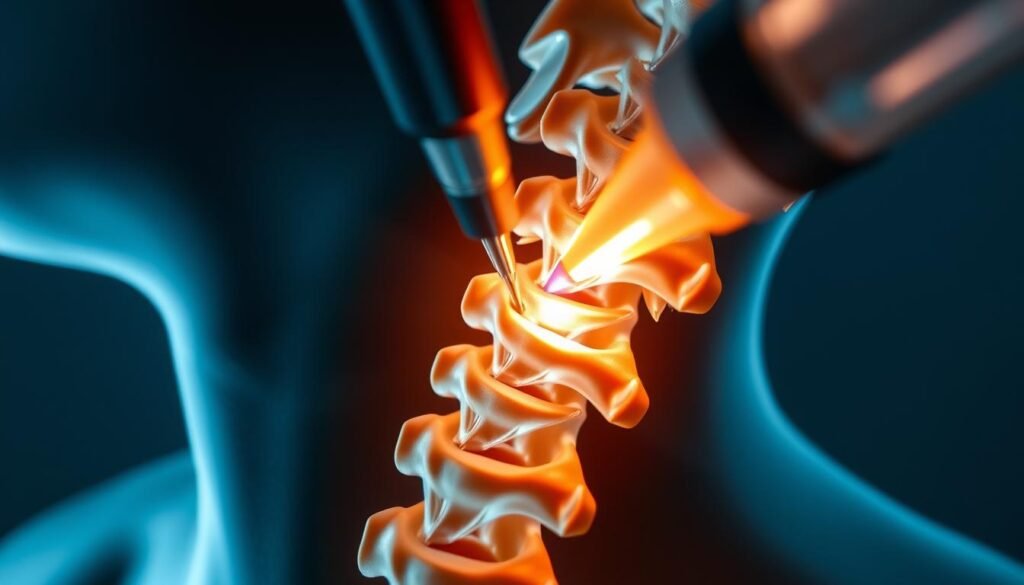Chronic neck pain can be debilitating, affecting every aspect of life. For those who have tried various treatments without finding lasting relief, there’s hope in a minimally invasive procedure known as radiofrequency ablation. This technique offers a significant breakthrough for individuals suffering from persistent neck pain.
The procedure involves using heat generated from radio waves to target specific nerve tissues in the neck that transmit pain signals to the brain. By disrupting these signals, patients can experience substantial pain relief. Unlike more invasive surgical interventions, this procedure requires minimal recovery time, making it an attractive option for those seeking to regain their quality of life.
Key Takeaways
- Radiofrequency ablation is a minimally invasive procedure for chronic neck pain relief.
- It targets specific nerve tissues to disrupt pain signal transmission.
- The procedure offers significant relief with minimal recovery time.
- It’s an effective option for patients who haven’t responded to conservative treatments.
- Understanding the benefits and outcomes can help patients make informed decisions.
Understanding Cervical Radio Frequency Ablation
Cervical RFA is a specialized treatment that targets the root cause of chronic pain in the neck region. It involves the use of radiofrequency energy to create controlled lesions on specific nerves that transmit pain signals.
What Is Cervical RFA?
Cervical Radio Frequency Ablation is a medical procedure that utilizes heat to disable nerve tissue, preventing it from transmitting pain signals to the brain. This procedure is particularly beneficial for individuals experiencing chronic pain related to cervical spine changes.

How Cervical RFA Differs from Other Pain Treatments
Unlike temporary pain treatments such as medication or injections, Cervical RFA provides longer-lasting pain relief, often lasting from six months to over a year. By targeting the source of pain rather than just masking symptoms, Cervical RFA offers a more sustainable approach to managing chronic pain. The procedure is performed on an outpatient basis, allowing for minimal recovery time.
How Cervical Radio Frequency Ablation Works

The mechanism behind Cervical Radio Frequency Ablation involves the use of radio waves to create lesions on targeted nerves. This procedure is designed to provide relief from chronic pain by disrupting the transmission of pain signals to the brain.
The Science Behind Pain Signal Disruption
The science behind cervical RFA involves using radio waves to generate heat that creates controlled lesions on the medial branch nerves, disrupting their ability to transmit pain signals to the brain. During the procedure, a specialized needle is precisely positioned near the targeted medial branch nerves under fluoroscopic (X-ray) guidance to ensure accuracy.
Targeting Medial Branch Nerves
The procedure specifically targets the medial branch nerves that innervate the facet joints in the cervical spine, which are often the source of chronic neck pain. Once properly positioned, an electrode inserted through the needle delivers radiofrequency energy that heats the surrounding tissue to approximately 80°C, creating a lesion that blocks pain signal transmission. For more information on Radiofrequency Ablation, you can visit the Cleveland Clinic’s website.
Conditions Treated with Cervical RFA
Conditions such as chronic neck pain and cervicogenic headaches can benefit from Cervical RFA treatment. Cervical radiofrequency ablation is a versatile treatment option that addresses various chronic pain conditions related to the cervical spine.
Chronic Neck Pain and Cervicogenic Headaches
Cervical RFA is primarily used to treat chronic neck pain that originates from the facet joints. This pain often develops due to degenerative changes, injury, or arthritis. Cervicogenic headaches, a specific type of headache stemming from issues in the cervical spine, are also effectively managed with this procedure. Approximately 4.1% of the population experiences cervicogenic headaches, with the average age of onset around 43.
Facet Joint Pain and Arthritis
Facet joint pain, characterized by discomfort during neck movement and tenderness along the spine, responds well to cervical RFA when other treatments have failed. Patients with arthritis in the cervical spine who experience pain from inflammation and degeneration of the facet joints can find significant relief through this procedure.
| Condition | Description | Benefit from Cervical RFA |
|---|---|---|
| Chronic Neck Pain | Pain originating from facet joints due to degenerative changes, injury, or arthritis | Effective pain relief |
| Cervicogenic Headaches | Headaches stemming from cervical spine issues | Significant reduction in headache frequency and severity |
| Facet Joint Pain | Discomfort during neck movement and tenderness along the spine | Relief from pain |
| Arthritis in Cervical Spine | Pain from inflammation and degeneration of facet joints | Significant pain relief |
Cervical RFA may also benefit patients with whiplash-associated disorders and chronic pain following neck surgeries when the pain originates from the medial branch nerves. By targeting these nerves, Cervical RFA provides a valuable treatment option for patients suffering from chronic pain related to the cervical spine.

Ideal Candidates for the Procedure

Cervical RFA is a procedure that can provide relief for individuals with chronic neck pain stemming from the facet joints in the cervical spine. Candidates typically have chronic neck pain traced to the facet joints.
When to Consider Cervical RFA
Ideal candidates are patients with chronic neck pain lasting three to six months that hasn’t responded to conservative treatments. A positive response to diagnostic medial branch blocks is crucial, with patients needing at least 50-80% pain relief.
Contraindications and Limitations
Contraindications include active infection, bleeding disorders, and certain implanted devices. Patients with multiple pain generators may experience limited benefits from cervical radiofrequency ablation.
The Cervical RFA Procedure Process

The cervical radiofrequency ablation procedure is a minimally invasive treatment for chronic pain relief. This procedure involves using radiofrequency energy to disrupt pain signals transmitted to the brain.
Pre-Procedure Preparation
Before undergoing cervical RFA, patients must undergo a comprehensive evaluation, including a medical history review, physical examination, and diagnostic imaging to confirm the pain source. They may need to stop certain medications, like blood thinners, to reduce bleeding risk.
What Happens During the Procedure
During the procedure, the patient lies on their stomach while the physician uses fluoroscopic guidance to position a specialized needle near the targeted medial branch nerves. Once the needle is properly positioned, a small amount of electrical current is applied to verify correct placement.
After confirmation, local anesthetic is administered, followed by the delivery of radiofrequency energy through the needle for approximately 90 seconds per site, creating a lesion that disrupts the nerve’s pain signal transmission.
Sedation Options and Pain Management
Sedation options range from minimal to moderate sedation, depending on patient preference and medical necessity. Most procedures are performed under local anesthesia with light sedation. For more information on cervical medial branch radiofrequency ablation, visit Cahaba Pain.
Benefits and Effectiveness of Cervical RFA
Research into Cervical RFA has highlighted its benefits in reducing chronic pain. Cervical Radio Frequency Ablation is a procedure that has shown significant promise in providing relief to patients suffering from chronic neck pain and related conditions.

Expected Pain Relief and Duration
Patients undergoing Cervical RFA can expect substantial pain relief, with studies indicating that approximately 54% of patients experience at least a 50% reduction in pain intensity. The duration of this relief varies, typically lasting between 6 to 14 months, although some patients have reported benefits extending up to 42 months.
Clinical Success Rates
Cervical RFA has demonstrated encouraging success rates in clinical studies. The procedure is particularly effective for patients who respond well to diagnostic blocks, offering them a significant reduction in pain and improved quality of life. By disrupting pain signals to the brain, Cervical RFA provides a valuable treatment option for those suffering from chronic pain, potentially reducing reliance on medication and associated side effects.
Potential Risks and Side Effects
While Cervical Radio Frequency Ablation is generally considered safe, it’s crucial to understand the potential risks and side effects associated with the procedure. As with any medical treatment, there are possible complications that can arise, ranging from mild to more serious effects.
Common Side Effects
Common side effects following Cervical Radio Frequency Ablation include temporary soreness at the injection site, mild bruising, and increased pain sensitivity. These symptoms typically resolve within a few days to weeks. Some patients may also experience dizziness, discomfort or pain, poor coordination, or skin numbness.

Rare Complications to Be Aware Of
Rare but more serious complications can include infection at the injection site, bleeding (especially in patients on blood thinners), nerve damage, and in extremely rare cases, spinal cord injury. Patients with certain medical conditions, such as active infections or bleeding disorders, may face increased risks.
Managing Post-Procedure Discomfort
Managing post-procedure discomfort typically involves using ice packs on the injection site, taking prescribed or over-the-counter pain medications as directed, and avoiding strenuous activities for 24-48 hours after the procedure. By following these guidelines, patients can minimize their discomfort and ensure a smoother recovery.
Recovery and Aftercare
After undergoing cervical radiofrequency ablation, patients enter a critical phase of recovery and aftercare that significantly influences the procedure’s success. The initial days following the cervical RFA procedure are crucial for setting the stage for optimal pain relief.
Immediate Post-Procedure Care
Immediately after the ablation, patients should arrange for someone to drive them home and plan to rest for the remainder of the day. Some patients may experience temporary increased pain or discomfort due to nerve irritation, which can be managed with prescribed medications or over-the-counter pain relievers. It’s essential to monitor for signs of complications such as persistent or worsening pain, fever, or new neurological symptoms.
Long-Term Pain Management Strategies
For sustained pain relief, a comprehensive approach is often recommended, combining physical therapy to strengthen neck muscles, proper ergonomics, stress management techniques, and occasional follow-up treatments. Physical therapy plays a crucial role in recovery by improving neck mobility and teaching proper body mechanics to prevent future pain episodes.
| Recovery Stage | Care Instructions | Expected Outcome |
|---|---|---|
| Immediate Post-Procedure | Rest, manage pain with medication | Minimize discomfort, prevent complications |
| Short-Term (First Week) | Avoid strenuous activities, heavy lifting | Allow healing, reduce risk of complications |
| Long-Term | Engage in physical therapy, maintain proper ergonomics | Achieve sustained pain relief, improve quality of life |
Conclusion
Cervical Radio Frequency Ablation has emerged as a significant advancement in managing chronic neck pain. By disrupting pain signals from the medial branch nerves to the brain, this procedure offers substantial relief for suitable candidates. Although not a permanent solution due to nerve regeneration, cervical RFA is a repeatable treatment with demonstrated clinical success and minimal downtime. Proper patient selection and diagnostic testing are crucial. With its potential to improve quality of life and reduce reliance on pain medications, cervical RFA is a viable option for those suffering from chronic neck pain.

